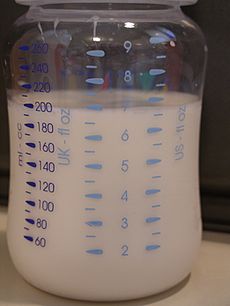System of units facts for kids
Imagine you want to measure things like how tall you are or how much something weighs. A system of units is like a special set of tools or rules for measuring different things. These tools (units) work together in a way that makes sense and doesn't cause confusion. For example, if you know how long something is, you can also figure out its area or volume using the same system.
Contents
Building Blocks of Measurement: Base and Derived Units
In any measurement system, some units are super important. We call them base units. Think of them as the building blocks. These units are chosen first and are independent of each other.
Then, there are derived units. These units are made by combining the base units. For example, if you measure length in meters (a base unit), you can measure area in square meters (a derived unit, because it's meters multiplied by meters).
Common Measurement Systems
Today, the most common measurement systems around the world are:
- The International System of Units (SI)
- The Imperial units
- The United States customary units
The International System of Units (SI)
The SI system is used by most countries. It has seven base units:
- The metre (for length)
- The second (for time)
- The kilogram (for mass)
- The ampere (for electric current)
- The kelvin (for temperature)
- The candela (for light intensity)
- The mole (for amount of substance)
SI also has many derived units. Some examples include the watt (for power), the newton (for force), and the joule (for energy). SI is known as a "coherent system." This means that when you use its units in formulas, you don't need to add any extra numbers or conversion factors. Everything just fits together perfectly.
Imperial and US Customary Systems
The Imperial system is mostly used in the United Kingdom, and the US customary system is used in the United States. They share some base units:
- The pound avoirdupois (for mass)
- The yard (for length)
- The second (for time)
Derived units in these systems include horsepower (for power) and Pounds per square inch (for pressure).
What Makes a System "Coherent"?
A measurement system is called coherent if its derived units are directly related to its base units without needing any extra numbers or constants in the formulas. It's like a puzzle where all the pieces fit together simply.
Let's look at the relationship between force, energy, and power as an example:
- Force is how much push or pull there is.
- Energy is the ability to do work.
- Power is how fast work is done.
In a coherent system, the formulas for these would look simple:
- force = mass × acceleration
- energy = force × distance
- power = energy / time
Coherence in Different Systems
SI System Coherence
The SI system is a coherent system. Here's how its units fit together:
- Newtons (unit of force) = kilograms (mass) × metres per second squared (acceleration)
- Joules (unit of energy) = newtons (force) × metres (distance)
- Watts (unit of power) = joules (energy) / second (time)
Notice there are no extra numbers in these equations. This makes SI easy to use for scientific calculations.
CGS System Coherence
The cgs system is another coherent system. It uses centimetres, grams, and seconds as its base units.
- Dynes (unit of force) = grams (mass) × centimetres per second squared (acceleration)
- Ergs (unit of energy) = dynes (force) × centimetres (distance)
- Ergs per second (unit of power) = ergs (energy) / second (time)
Just like SI, the cgs system doesn't need any extra numbers in its formulas, so it's also coherent.
Non-Coherent Systems
Some systems are not coherent. For example, the MKS-gravitational system uses units like kilogram-force and Pferdestärke (a type of horsepower).
- Kilogram-force = kilograms × metres per second squared / 9.80665
- Pferdestärke = 75 × kilogram-force × metres / seconds
Because these equations have extra numbers (like 9.80665 and 75), the MKS-gravitational system is not considered coherent.
See also
 In Spanish: Sistema de unidades para niños
In Spanish: Sistema de unidades para niños


